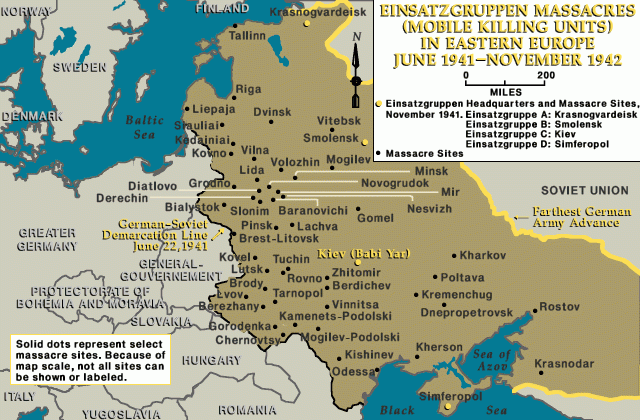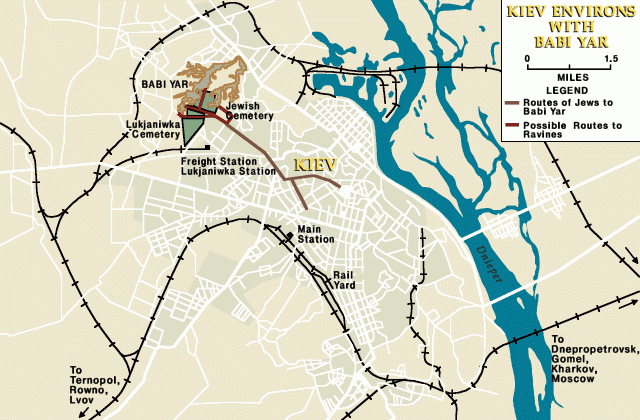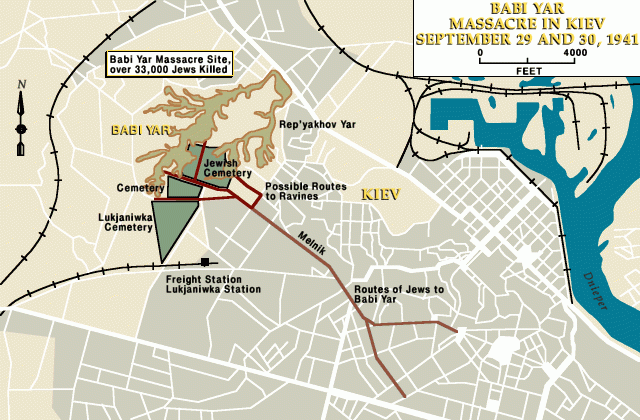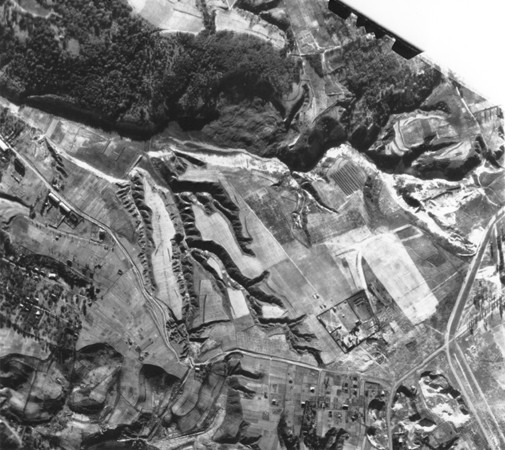
Mass Shootings at Babyn Yar (Babi Yar)
In late September 1941, SS and German police units and their auxiliaries perpetrated one of the largest massacres of World War II. It took place at a ravine called Babyn Yar (Babi Yar) just outside the Ukrainian capital city of Kyiv.
Key Facts
-
1
Babyn Yar in Kyiv was the site of one of the largest mass shootings of Jews in German-occupied Europe. It occurred on September 29–30, 1941.
-
2
Germans continued to perpetrate mass murders at this killing site until just before the Soviets re-took control of Kyiv in 1943. During this period, Germans shot Jews, as well as Roma, Ukrainian civilians, and Soviet POWs.
-
3
In the decades after the war, Babyn Yar symbolized the struggle over the memory of World War II and the Holocaust in the Soviet Union.
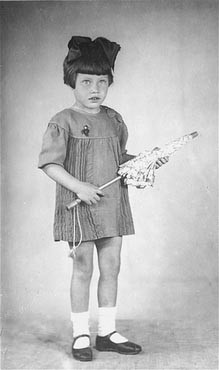
On September 19, 1941, German forces entered the city of Kyiv (Kiev), the capital of Ukraine. Along with a large part of German-occupied Ukraine, the city was incorporated into the Reichskommissariat Ukraine which had been established on September 1 with Erich Koch as administrator (Reichskommissar).
Before the German invasion, some 160,000 Jews resided in Kyiv. This was approximately 20 percent of the total population of the capital. Following the start of Operation Barbarossa in June 1941, approximately 100,000 Jews fled Kyiv or were already serving in the Soviet military. By the time the Germans occupied Kyiv, there were about 60,000 Jews remaining in the city. Most of those who remained had been unable or unwilling to flee earlier. This included mostly women, children, the elderly, and those who were ill.
The Massacre at Babyn Yar (September 29–30, 1941)
During the first week of the German occupation of Kyiv, there were two major explosions. These explosions destroyed the German headquarters and areas around the main street of the city center (Khreshchatyk Street). A large number of German soldiers and officials were killed in the blasts. Though the explosions were caused by mines left by retreating Soviet soldiers and officials, the Germans used the sabotage as a pretext to murder those Jews who still remained in Kyiv.
On September 29–30, 1941, SS and German police units and their auxiliaries, under the guidance of members of Einsatzgruppe C, murdered a significant number of the Jewish population who remained in Kyiv. The massacre occurred at a ravine called Babyn Yar (sometimes spelled “Babi Yar” in English). At the time, the ravine was located just outside the city.
The victims were summoned to the site, forced to undress, and then compelled to enter the ravine. Sonderkommando 4a, a special detachment from Einsatzgruppe C under SS-Standartenführer Paul Blobel, shot them in small groups. According to reports sent to the Einsatzgruppen headquarters in Berlin, 33,771 Jews were massacred during this two-day period.
The massacre at Babyn Yar was one of many mass shootings perpetrated by the Nazi Germans beginning in 1941. It was also one of the largest mass killings at a single location during World War II.
Other Mass Shootings at Babyn Yar (1941–1943)
The ravine at Babyn Yar was a killing site for two years after the September 1941 massacre. There, Germans stationed at Kyiv murdered tens of thousands of people, both Jews and non-Jews. Other groups of people who were killed at Babyn Yar included: patients from a local psychiatric hospital, Roma (Gypsies), Soviet prisoners of war, and non-Jewish civilians.
The killings at the Babyn Yar ravine continued until the fall of 1943. Nazi authorities suspended them only a few days before the Soviets re-took control of Kyiv on November 6.
It is estimated that, in total, some 100,000 people, Jews and non-Jews, were murdered at Babyn Yar under the German occupation.
Attempts to Cover up the Crime (Summer 1943)
With the Red Army approaching Kyiv in the summer of 1943, the Germans embarked on a cover-up operation to conceal the mass murders at Babyn Yar. To do so, they used prisoners who were being held at the Syrets labor education camp located close to the Babyn Yar ravine. The Syrets camp was established by the Germans in May 1942. It served to intern Soviet POWs, partisans, Jews who had survived the mass shooting actions of late September 1941, and non-Jewish civilians (Ukrainians, Russians, and others) accused of various crimes.
To cover up the mass shootings at Babyn Yar, the Germans ordered approximately 300 prisoners from Syrets to dig up the mass graves and burn the remains of victims. Most of the prisoners involved in this cover-up operation were murdered by the Germans once the operation was complete. However, a handful of the inmates escaped and testified about the Germans’ crimes to Soviet authorities after November 1943.
Postwar Justice
In January 1946, 15 members of the German police were tried in Kyiv for the crimes committed at Babyn Yar. Dina Pronicheva, a Jewish survivor of the September massacre, testified before a Soviet court. In one of her written postwar testimonies, Pronicheva described what she saw at Babyn Yar:
Each time I saw a new group of men and women, elderly people, and children being forced to take off their clothes. All [of them] were being taken to an open pit where submachine-gunners shot them. Then another group was brought…. With my own eyes I saw this horror. Although I was not standing close to the pit, terrible cries of panic-stricken people and quiet children’s voices calling “Mother, mother…” reached me.
In 1947, Paul Blobel was tried before the American military tribunal in Nuremberg. He was the commander of Sonderkommando 4a, the Einsatzgruppe unit responsible for the September 1941 massacre of Jews at Babyn Yar. Blobel was one of 24 defendants in the Einsatzgruppen Trial and pleaded not guilty. His defense argued that he had simply been following orders. Nonetheless, Blobel was convicted and sentenced to death. He was hanged at the Landsberg prison on June 8, 1951.
In 1959, Erich Koch, who had served as Reichskommissar in Ukraine, was tried and sentenced to death by a Polish court for crimes committed in occupied Poland during World War II. He was never tried or convicted for his war crimes in occupied Ukraine. Due to ill health, Koch’s sentence was commuted to life in prison. He died of natural causes in his prison cell at Barczewo prison in Poland on November 12, 1986.
Postwar Memorialization
In the immediate decades after the war, Babyn Yar became a symbol of struggles over the memory of World War II and the Holocaust in the Soviet Union. Despite many efforts, there was no memorial at the site until the Soviets installed a monument in 1976. Deemphasizing the Jewish tragedy at Babyn Yar, the text on the monument referred to the site’s estimated 100,000 victims without indicating that approximately one-third of them were Jews killed in the late September 1941 massacre.
As the Soviet Union was dissolving in the wake of Ukraine’s declaration of independence in August 1991, a Menorah-shaped monument to the Jewish victims of Babyn Yar was erected on September 29, the 50th anniversary of the mass shooting. The site, which is now a public park, and the surrounding area have since seen a proliferation of monuments to various groups of victims of the German occupation.
Footnotes
-
Footnote reference1.
Excerpt from “Testimony of Dina Pronicheva about the Annihilation of the Jews in Babi Yar on September 29-30, 1941” available from Yad Vashem Written Testimonies. Originally published in Yitzhak Arad, ed., The Destruction of the Jews of the USSR during the German Occupation (1941-1944), Jerusalem 1991, pp. 107-111 (in Russian).
Critical Thinking Questions
What pressures and motivations may have affected soldiers to volunteer for the Einsatzgruppen and later murder innocent civilians?
Investigate what penalties there may have been for refusing to shoot Jews.
Learn about the postwar Einsatzgruppen trial.



